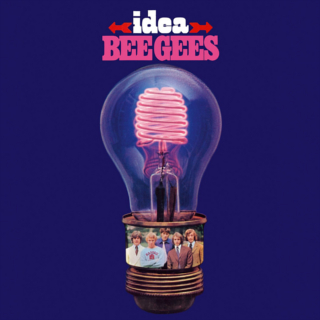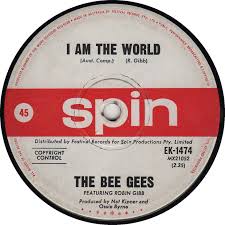
Sir Barry Alan Crompton Gibb is a British musician, singer, songwriter and record producer. He rose to worldwide fame as a member of the Bee Gees, one of the most commercially successful groups in the history of popular music. With his younger brothers, fraternal twins Robin and Maurice Gibb, he formed a musical partnership beginning in 1955. He has lived in Britain, Australia, and the United States, holding dual UK–US citizenship, the latter since 2009.

Best of Bee Gees is a 1969 compilation album by the English-Australian rock band Bee Gees. It was their first international greatest hits album. It featured their singles from 1966-1969 with the exception of the band's 1968 single "Jumbo".

Odessa is the sixth studio album by the Bee Gees, a double vinyl LP released on 30 March 1969, initially in an opulent red flocked cover with gold lettering. Despite reaching the UK Top Ten and the US Top 20, the album was not particularly well-received, though now is regarded by many as the most significant of the group's Sixties albums. An ambitious project, originally intended as a concept album on the loss of a fictional ship in 1899, it created tension and disagreements in the band regarding the work's direction; finally, a dispute over which song to release as a single led to Robin Gibb temporarily leaving the group.

Idea is the fifth album by the Bee Gees. Released in September 1968, the album sold over a million copies worldwide. The album was issued in both mono and stereo pressings in the UK. The artwork on the Polydor release designed by Wolfgang Heilemann featured a "beehive" neon lightbulb with a group photo in its base, while the North American ATCO release designed by Klaus Voormann featured a composite head made from each band member. It was their third internationally released album – the first two albums being released only in the Australian market.

Spicks and Specks is the second studio album by the Bee Gees. It was released in November 1966, on Spin. Primarily written by Barry Gibb, the album includes the first Robin Gibb composition "I Don't Know Why I Bother With Myself" and a Maurice Gibb composition "Where Are You".

"How Can You Mend a Broken Heart" is a song released by the Bee Gees in 1971. It was written by Barry and Robin Gibb and was the first single on the group's 1971 album Trafalgar. It was their first US No. 1 single and also reached No. 1 in Cashbox magazine for two weeks.
"Melody Fair" is a song by the Bee Gees, written by Barry, Robin & Maurice Gibb in 1968 and released in 1969 on their album Odessa. It was not released as a single, but this song was played on many radio stations, and was a hit in Japan. Andy Gibb's 1974 group, named Melody Fayre was named after this song. It also featured as the theme to Melody, a British film featuring a number of Bee Gees songs in its soundtrack.

Bee Gees' 1st is the third studio album by English group Bee Gees, and their first international full-length recording after two albums distributed only in Australia and New Zealand. Bee Gees' 1st was the group's debut album for the UK Polydor label, and for the US Atco label. Bee Gees 1st was released on 14 July 1967 in the UK. On 9 August it entered the UK charts; on that same day, the album was released in the US, and it entered the US charts on 26 August.

"Don't Wanna Live Inside Myself" is a ballad written and sung by Barry Gibb, and released on the Bee Gees' album Trafalgar in 1971, and the second single release taken from the album.
"I Can't See Nobody" is a song by the Bee Gees, released first as the B-side of "New York Mining Disaster 1941". With "New York Mining Disaster 1941", this song was issued as a double A in Germany and Japan, and included on the group's third LP, Bee Gees' 1st. "I Can't See Nobody" charted for one week at number 128 on the Billboard Bubbling Under the Hot 100 in July 1967.

"All of My Life" is a song by the English-Australian rock group Bee Gees, written and sung by Barry Gibb, which was used as the B-side of "Monday's Rain". This song was recorded during the sessions for their second album Spicks and Specks and appeared on the early pressings of the album, entitled Monday's Rain as the first song on side two. When the album's name was changed to Spicks and Specks, the song was omitted.

The Ultimate Bee Gees is a compilation album released to coincide with the 50th anniversary of the Bee Gees. Although the group did not start recording until 1963 on Festival Records in Australia, they began calling themselves the "Bee Gees" in 1959 after several name changes such as "Wee Johnny Hayes and the Bluecats", "The Rattlesnakes" and "BG's". Each disc is themed with the first containing more upbeat songs, called A Night Out, and the second containing slower songs and ballads, called A Night In, though the cover art does not distinguish this theme. Liner notes were written by Sir Tim Rice. This also marks the return of the 1970s era logo on an official Bee Gees release, which was last used on the Bee Gees' 1983 single "Someone Belonging to Someone".
"Bury Me Down By the River" is a song written by Barry and Maurice Gibb and recorded separately by the Bee Gees and P.P. Arnold. The Bee Gees' version was recorded in May 1969 at IBC Studios and released in April 1970 on the album Cucumber Castle.

The Kid's No Good was to have been the debut solo album by British musician Barry Gibb following his departure from the Bee Gees in December 1969. There was no official title given to the album at the time. The line "the kid's no good", which the album is commonly titled on several bootleg releases, is also featured in the Bee Gees song "Come Home Johnny Bridie" on the 1973 album Life in a Tin Can. The album features orchestral arrangements by Bill Shepherd who performed the same role for the Bee Gees from 1965 to 1972.
"Kitty Can" is a song by the Bee Gees, composed by Barry, Robin & Maurice Gibb. It was released as the B-side of "I've Gotta Get a Message to You" in July 1968, and as the second track on the album Idea in September 1968. In 1973, RSO Records released a compilation called Kitty Can only in Argentina and Uruguay, and this song appeared as the first track on that album.

"Saved by the Bell" is a 1969 single written and recorded by Robin Gibb. It was released in June 1969, and has been certified gold. It was the lead single on Gibb's debut album Robin's Reign, released in early 1970. According to Vinyl Records, the song was co-produced by Kenny Clayton. Gibb also made a promotional video for this song. The song gained commercial success in Europe, but was a commercial failure in the US.

"I Am the World" is a song recorded by the Bee Gees, written and sung by Robin Gibb. It was released as the B-side of "Spicks and Specks". Later, it was included on the compilation Rare, Precious and Beautiful, Vol. 3 in 1969. It featured trumpet played by Geoff Grant. Its CD version was released in 1998 on the compilation Brilliant from Birth.
Turn Around, Look at Us was the first compilation album released by the Bee Gees in 1967 on Festival Records. It was released only in Australia and New Zealand. The album effectively served as a mop-up compilation, featuring all the group's single tracks that had not been available on their two Australian albums, though three tracks from The Bee Gees Sing and Play 14 Barry Gibb Songs made repeat appearances.

Rare, Precious and Beautiful, Volume 2 is a compilation released by the Bee Gees in 1968 on Polydor Records in the UK and Karussell Records in Germany. The album was released in the US on Atco Records in 1970. The songs were recorded between 1963 and 1966.
Inception/Nostalgia is a 1970 compilation album of previously unreleased songs recorded by the Bee Gees in 1966. This double album contains a mixture of both self-penned songs and covers. The first LP in the set is titled Inception while the second LP is titled Nostalgia, hence the album title. Supposedly intended as a follow-up to the three volumes of Rare, Precious and Beautiful this set was first issued by Karussell in Germany and by Triumph in France, both being Polydor budget labels and therefore linked to their licensing deal with Festival Records. The Gibb brothers were unaware of its release until Maurice saw one during a skiing holiday in Switzerland. It did not remain in print for long but it was released by Polydor in Japan in 1972 as Inception and Nostalgia and a number of single disc releases with a varying selection of these songs appeared on a number of compilations across the world over the next few years.














